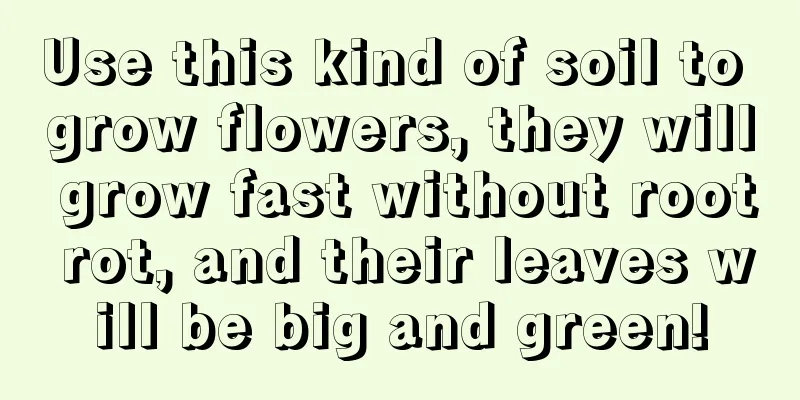Use this kind of soil to grow flowers, they will grow fast without root rot, and their leaves will be big and green!

What are the types of soil?1. Garden soilSource: Mostly from vegetable gardens, roadsides, and fields Advantages: slightly acidic, strong water and fertilizer retention capacity Disadvantages: Poor water and air permeability, which can easily cause hardening over time 2. Leaf moldSource: Woods, bamboo forests, etc. Advantages: Leaf mold is formed by long-term decay and fermentation of leaves, etc. It has a loose texture and good water and fertilizer retention. Disadvantages: Insect eggs and bacteria will be brought in when collecting leaf mold. It has poor water permeability when it is moist, and the roots are prone to rot. 3. Pine Needle SoilSource: Surface soil under pine, cypress and other trees Advantages: Weakly acidic, sufficient nutrients, loose and breathable Disadvantages: Poor water retention 4. Peat soilSource: fish ponds, ponds, river and lake bottoms Advantages: sufficient nutrients, soft and breathable, good water and fertilizer retention Disadvantages: Long time will cause soil compaction 5. Coconut branSource: Bought Advantages: Coconut bran has strong water and air permeability, and can completely replace peat soil, and the price is much cheaper than peat soil. Disadvantages: Using only coconut coir to grow succulents can easily lead to fragile root systems and stunted seedlings. Add some of this to the soil to keep it water-permeable and prevent root rotThe soils introduced by Huahua above each have their own advantages and disadvantages. None of them can grow flowers completely without any problems. Therefore, we need to add something to the soil to make up for the shortcomings of the soil. 1. Add some sand to the soilSand has very good air permeability and drainage properties, and is very clean and hygienic. It also contains trace elements such as iron and magnesium, and can be absorbed by flowers, so sand is considered to be a very good thing. 2. Add some pine bark to the soilPine bark has a very strong ability to absorb water. Mixing it in the soil can retain moisture and prevent the soil from becoming compacted. If you add pine bark when growing flowers, you don’t need to add perlite and vermiculite. 3. Add some sawdust to the soilSawdust is the most common thing in our daily life, especially when decorating the house, we can often see leftover sawdust. Sawdust is also a good thing for growing flowers. It has very good water and air permeability. However, it is best to compost it before use to avoid root rot. 4. Add some perlite to the soilPerlite can absorb 2-3 times its own amount of water, and has excellent water permeability and air permeability. After watering, it will slowly float to the surface of the soil and will be blown away by the wind, so perlite can also be mixed into the soil. 5. Add some ceramsite to the soilExpanded clay comes in different sizes, and its biggest feature is its good air permeability. It is usually placed at the bottom of a flower pot, mixed with soil, or spread on the surface of the pot. How to prepare soil for common flowers in the homeSo much has been introduced about flowers above, so some flower lovers may ask, how to prepare the soil for the flowers at home? Today Huahua will talk to you about this issue. 1. Large plants such as fortune trees and lucky treesLarge potted plants such as money trees and lucky trees are particularly prone to root rot, so the soil must have good drainage. Soil ratio: garden soil, organic fertilizer, sand, coal slag = 6: 2: 2: 1 2. Foliage plants such as green radish, spider plant, and ivySeedling stage: leaf mold, garden soil, sand = 4: 3: 2 Growing period: leaf mold, garden soil, sand = 1: 1: 1 3. CliviaMainly grow leaves: Leaf mold, pine needles, sand, castor (bone meal) = 5: 3: 1: 1 Mainly for root care: Leaf mold, pine needles, sand, bone meal, ceramsite (perlite) = 3: 4: 1.5: 1: 0.5 4. SucculentsCuttings, leaf cuttings, beheading and soil preparation: Wet weather: seedling peat, perlite, vermiculite = 3: 2: 5 Dry weather: seedling peat, perlite, vermiculite = 2: 2: 6 Soil preparation for mature plants: Wet weather: peat (coconut peat), perlite, vermiculite, Akadama = 4: 1.5: 1: 3.5 Dry weather: peat (coconut peat), perlite, vermiculite, Akadama = 6:1.5:1.5:1 5. Gardenia, jasmine, camellia and other acid-loving flowersSoil preparation method 1: peat soil, sand, bone meal = 6: 3: 1 Soil preparation method 2: pine needle soil, sandy soil, garden soil, organic fertilizer = 4: 4: 1: 1 6. RoseSoil preparation for seedlings and bare-root seedlings: Peat soil, garden soil, vermiculite (river sand, perlite) = 3:1:1 Peat soil, garden soil, vermiculite (river sand, perlite) 1: 3: 1 Soil preparation for medium and large seedlings: Garden soil, leaf mold, river sand (vermiculite, perlite), organic fertilizer = 4: 3: 2: 1 7. Soil preparation for petunia, gypsophila and other grass flowersSoil preparation for sowing: Leaf mold, garden soil, river sand = 5: 3: 2 Potting soil: Leaf mold, garden soil, river sand, bone meal = 4: 5: 1: 0.5 Huahua introduced these soil preparation methods, Have all the flower lovers learned it? If you learn it, But don’t kill the flowers again! |
>>: How does the small hibiscus survive the winter?
Recommend
Can expired milk be used to water flowers?
1. Can it be watered? Don’t rush to throw away ex...
Phalaenopsis cutting method
After the Phalaenopsis flower period is over, cut...
Can hibiscus be pruned in autumn? (When and how to prune hibiscus)
Is it okay to prune hibiscus in autumn? The pruni...
Green treasure tree cultivation methods and precautions
1. Maintenance methods 1. Temperature: During the...
Which month is best to plant cucumbers?
Cucumber is a very common crop in rural areas. Cu...
How many years does it take for a Meizao cherry tree to bear fruit?
Introduction to Zhongmei Early Cherry Mei Zao che...
How often should I water my Green Diamond?
How often should I water my Green Diamond? The fr...
How long can the seeds of the red spider lily be kept and when is the sowing period
1. How long can the seeds of the red spider lily ...
The difference between Mizilan and Jiulixiang
1. Difference of blades The Mi Zai Lan has 3-5 sm...
Cultivation methods and precautions of tricolor millennium wood
1. Soil It is recommended to use a nutritious, br...
Can Syngonium be hydroponically cultivated? Is hydroponics better or soil cultivation better?
Can Syngonium be hydroponically cultivated? Syngo...
Hydrangea flower arrangement maintenance
Maintenance points 1. After receiving the hydrang...
How to grow Anthurium hydroponically
1. Transplantation First dig it out of the soil, ...
How to grow purple spiderwort? Can it be placed in the bedroom?
1. Breeding methods 1. Light: It likes light very...
How to grow Jiuzhuanhua at home
Nine-turn flower growth conditions The nine-turn ...









